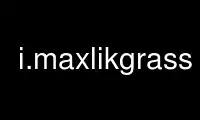
This is the command i.maxlikgrass that can be run in the OnWorks free hosting provider using one of our multiple free online workstations such as Ubuntu Online, Fedora Online, Windows online emulator or MAC OS online emulator
PROGRAM:
NAME
i.maxlik - Classifies the cell spectral reflectances in imagery data.
Classification is based on the spectral signature information generated by either
i.cluster, g.gui.iclass, or i.gensig.
KEYWORDS
imagery, classification, Maximum Likelihood Classification, MLC
SYNOPSIS
i.maxlik
i.maxlik --help
i.maxlik group=name subgroup=name signaturefile=name output=name [reject=name]
[--overwrite] [--help] [--verbose] [--quiet] [--ui]
Flags:
--overwrite
Allow output files to overwrite existing files
--help
Print usage summary
--verbose
Verbose module output
--quiet
Quiet module output
--ui
Force launching GUI dialog
Parameters:
group=name [required]
Name of input imagery group
subgroup=name [required]
Name of input imagery subgroup
signaturefile=name [required]
Name of input file containing signatures
Generated by either i.cluster, g.gui.iclass, or i.gensig
output=name [required]
Name for output raster map holding classification results
reject=name
Name for output raster map holding reject threshold results
DESCRIPTION
i.maxlik is a maximum-likelihood discriminant analysis classifier. It can be used to
perform the second step in either an unsupervised or a supervised image classification.
Either image classification methods are performed in two steps. The first step in an
unsupervised image classification is performed by i.cluster; the first step in a
supervised classification is executed by the GRASS program g.gui.iclass. In both cases,
the second step in the image classification procedure is performed by i.maxlik.
In an unsupervised classification, the maximum-likelihood classifier uses the cluster
means and covariance matrices from the i.cluster signature file to determine to which
category (spectral class) each cell in the image has the highest probability of belonging.
In a supervised image classification, the maximum-likelihood classifier uses the region
means and covariance matrices from the spectral signature file generated by g.gui.iclass,
based on regions (groups of image pixels) chosen by the user, to determine to which
category each cell in the image has the highest probability of belonging.
In either case, the raster map output by i.maxlik is a classified image in which each cell
has been assigned to a spectral class (i.e., a category). The spectral classes
(categories) can be related to specific land cover types on the ground.
NOTES
The maximum-likelihood classifier assumes that the spectral signatures for each class
(category) in each band file are normally distributed (i.e., Gaussian in nature).
Algorithms, such as i.cluster, g.gui.iclass, or i.gensig, however, can create signatures
that are not valid distributed (more likely with g.gui.iclass). If this occurs, i.maxlik
will reject them and display a warning message.
The signature file (signaturefile) contains the cluster and covariance matrices that were
calculated by the GRASS program i.cluster (or the region means and covariance matrices
generated by g.gui.iclass, if the user runs a supervised classification). These spectral
signatures are what determine the categories (classes) to which image pixels will be
assigned during the classification process.
The optional name of a reject raster map holds the reject threshold results. This is the
result of a chi square test on each discriminant result at various threshold levels of
confidence to determine at what confidence level each cell classified (categorized). It is
the reject threshold map layer, and contains the index to one calculated confidence level
for each classified cell in the classified image. 16 confidence intervals are predefined,
and the reject map is to be interpreted as 1 = keep and 16 = reject. One of the possible
uses for this map layer is as a mask, to identify cells in the classified image that have
a low probability (high reject index) of being assigned to the correct class.
EXAMPLE
Second part of the unsupervised classification of a LANDSAT subscene (VIZ, NIR, MIR
channels) in North Carolina (see i.cluster manual page for the first part of the example):
# using here the signaturefile created by i.cluster
i.maxlik group=lsat7_2002 subgroup=lsat7_2002 \
signaturefile=sig_cluster_lsat2002 \
output=lsat7_2002_cluster_classes reject=lsat7_2002_cluster_reject
# visually check result
d.mon wx0
d.rast.leg lsat7_2002_cluster_classes
d.rast.leg lsat7_2002_cluster_reject
# see how many pixels were rejected at given levels
r.report lsat7_2002_cluster_reject units=k,p
# optionally, filter out pixels with high level of rejection
# here we remove pixels of at least 90% of rejection probability, i.e. categories 12-16
r.mapcalc "lsat7_2002_cluster_classes_filtered = \
if(lsat7_2002_cluster_reject <= 12, lsat7_2002_cluster_classes, null())"
RGB composite of input data
Output raster map with pixels classified (10 classes)
Output raster map with rejection probability values (pixel classification confidence
levels)
Use i.maxlikgrass online using onworks.net services
